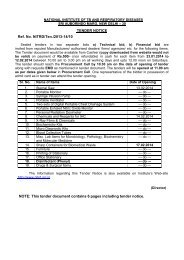October - LRS Institute of Tuberculosis & Respiratory Diseases
October - LRS Institute of Tuberculosis & Respiratory Diseases
October - LRS Institute of Tuberculosis & Respiratory Diseases
You also want an ePaper? Increase the reach of your titles
YUMPU automatically turns print PDFs into web optimized ePapers that Google loves.
162 D.D.S, KULPATI<br />
any further oxygen induced pulmonary damage.<br />
PEEP should be increased in increments <strong>of</strong><br />
3-5 cm H2O with careful monitoring and using<br />
volume infusions and inotropic agents as<br />
necessary to maintain adequate O2 delivery<br />
with Fi02 not greater than 0.5-0.6. This must<br />
be empirically determined in each patient at<br />
bedside clinically (skin temperature, cyanosis,<br />
features <strong>of</strong> cerebral hypoxia etc.) and also by<br />
measuring lung compliance, maximally obtainable<br />
reduction in venous admixture (shunt<br />
should be reduced to 25% or less) and by<br />
measuring mixed venous PO2 (MVO2) by<br />
flow directed Swan-Ganz catheter. The latter is<br />
the index <strong>of</strong> efficacy <strong>of</strong> entire therapeutic<br />
regimen as it reflect, oxygen delivery to tissues<br />
and hence cardiac output too. A low value<br />
(less than 20 mmHg) certainly indicates tissues<br />
hypoxacmia irrespective <strong>of</strong> measured cardiac<br />
output and Pao2. However high value does not<br />
exclude serious tissue. especially in gram<br />
negative Septicaemia where systemic low<br />
resistance shunts develop leaving several<br />
capillary beds unperfused. A fall in mixed<br />
venous PO2 while increasing PEEP, indicates<br />
decrease in cardiac output which more than<br />
<strong>of</strong>fsets any increase in PaO2 and tissue oxygention<br />
goes down.<br />
High levels <strong>of</strong> PEEP can decrease cardiac<br />
output (due to impeded systemic venous return<br />
and geometric changes and intraventricular<br />
septal shift decreasing cardiac compliance),<br />
impaired left ventricular function, increased<br />
chances <strong>of</strong> barotrauma (pneumothorax,<br />
pneumomediaslinum) increased extravascular<br />
lung water and may sometimes cause a paradoxical<br />
decrease in PaO2 (Qvist et al, 1975;<br />
Robotham et al, 1980). PEEP may be given<br />
early in high risk patients to prevent ARDS and<br />
later (late PEEP) to improve the survival.<br />
Today, early PEEP is much more rewarding<br />
than the later PEEP (Weigett et al. 1979;<br />
Petty and Fowler 1983).<br />
In patients with adequate ventilatory reserve<br />
(Vital capacity greater than 8 ml/kg) who can<br />
spontaneously maintain satisfactory PCO2,<br />
continuous positive airway pressure (CPAP)<br />
is probably preferable to PEEP as patients<br />
are more comfortable and mean airway<br />
pressures lower and thus less chance <strong>of</strong><br />
barotrauma.<br />
Extracorporeal membrane oxygenators (EC-<br />
MO) have been used where maximal PEEP<br />
with Fio2 <strong>of</strong> 1.0 does not supply adequate<br />
oxygen. A randomized large multicentric<br />
trial with 90 patients showed that though it<br />
can support gas exchange there was no difference<br />
in survival. Thus, experience with this mode<br />
<strong>of</strong> oxygenation has been disappointing (Zapol<br />
and Snider, 1980),<br />
Discontinuation <strong>of</strong> mechanical ventilatory<br />
support<br />
Ability <strong>of</strong> patient to maintain adequate<br />
gas exchange without ventilator is heralded<br />
by a decreasing FiO2, requirement <strong>of</strong> smaller<br />
inflation pressures for mandatory or assisted<br />
breathing and spontaneous respiratory rate<br />
<strong>of</strong> less than 30 per minute, spontaneous tidal<br />
volume <strong>of</strong> > 8 ml/kg, vital capacity <strong>of</strong> > 15ml/<br />
kg and ability to generate static inspiratory<br />
pressure >30 cm H2O. Despite this, some<br />
patients cannot sustain themselves for prolonged<br />
periods; so, multiple weaning trials are carried<br />
out. <strong>Respiratory</strong> muscle exercise by synchronixed<br />
intermittent mandatory ventilation or<br />
assisted control ventilation is helpful in increasing<br />
patient’s respiratory self-sufficiency.<br />
Inhibition <strong>of</strong> amplification response by corticosteroids<br />
Steroids may prevent complement mediated<br />
leucocyte aggregation and superoxide damage<br />
to endothelial cells. Capillary permeability<br />
following sepsis may be reduced following<br />
the use <strong>of</strong> methyl prednisolone (C<strong>of</strong>fin et al,<br />
1975; Brigham et al, 1981; Schonfeld et al,<br />
1983).<br />
If methylprednisolone is used, doses should<br />
be 30 mg/kg for 1-2 days, given at onset <strong>of</strong><br />
disease.<br />
Assessment <strong>of</strong> the patient<br />
Base-line arterial blood gases and chest<br />
roentgeuograms may be obtained to detect<br />
early manifestations <strong>of</strong> ARDS.<br />
I. Oxygenation : Since the level <strong>of</strong> arterial<br />
oxygen varies with concentration <strong>of</strong> oxygen<br />
inspired; a/A O2 ratio (or A-a O2 difference)<br />
is a better method <strong>of</strong> assessment <strong>of</strong> oxygenation<br />
especially for patients on ventilators. For<br />
example, a patient with a baseline PaO2 <strong>of</strong><br />
60 mmHg on 21 % inspired oxygen concentration<br />
has a PaO2 <strong>of</strong> 100 mmHg on 40 % oxygen.<br />
Is the patient better or worse ‘A’ is the<br />
alveolar O2 and is determined by the following<br />
equation:<br />
A = FiO2 (PB - PH 3 O) - 1.2 PaCO2<br />
=FiO2 (700) - 1.2 PaCO2<br />
At 21%A=.2I (700)- 1.2(40)<br />
=99 a/A Ratio=60/99 = .61<br />
At 40%A=.4(700)- 1.2(40)<br />
100<br />
=232 a/A ratio=<br />
232 ..43
















